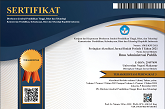Interest Affect and Type of benefits in the Implementation of the Slumless City Program in Bone Regency, South Sulawesi
(1) Universitas Negeri Makassar
(2) Universitas Negeri Makassar
(3) Universitas Negeri Makassar
(4) Universitas Sembilnbelas November Kolaka
(*) Corresponding Author
DOI: https://doi.org/10.26858/jiap.v11i2.26441
Abstract
The handling of slum areas through the City Without Slums program has been implemented in a number of areas since 2016, after the Ministry of Public Works and Public Housing issued Circular No. 40/SE/DC/2016. The program is expected to improve the quality of the environment so that the level of welfare and the regional economy will increase. Through this article, the researcher intends to provide an overview of the implementation of the City Without Slums program in Bone Regency, from the aspect of Interest Affect and Type of Benefits, through a qualitative research method. By using Interactive Model Analysis, in processing the data from the observations. documentation and interviews, it was found that the City Without Slums program in Bone Regency was carried out with an orientation to the public interest with a decentralized system and community empowerment. The government formulates a strategy for dealing with slum areas by paying attention to the suitability between community needs and existing problems, then the community is used as the main actor in implementing the strategy. This program has also provided collective benefits for the local government and the people of Bone Regency, in terms of the economy and the provision of public services. In order for the implementation of the KOTAKU program in Bone Regency to run optimally, the government needs to pay attention to the capabilities and number of existing program implementers.
Keywords
Full Text:
PDFReferences
Azzahra, S. A. (2020). Implementasi Program Kota Tanpa Kumuh (KOTAKU) di Kota Sukabumi (Studi Kasus Kecamatan Citamiang). Jurnal Administrasi Publik, 2(2), 26–33. https://doi.org/10.23969/decision.v2i2.3155
Butala, N. M., VanRooyen, M. J., & Patel, R. B. (2010). Improved health outcomes in urban slums through infrastructure upgrading. Social Science and Medicine, 71(5), 935–940. https://doi.org/10.1016/j.socscimed.2010.05.037
Christianingrum, S. I., & Djumiarti, T. (2019). Implementasi Program Kota Tanpa Kumuh di Kecamatan Semarang Timur. Journal of Public Policy and Management Review, 8(2). https://doi.org/10.14710/jppmr.v8i2.23515
Creswell, J. W. (2009). Research Design: Qualitative, Quantitative, and Mixed Methods Approaches. SAGE.
Das, M., Das, A., Giri, B., Sarkar, R., & Saha, S. (2
. Habitat vulnerability in slum areas of India – What we learnt from COVID-19? International Journal of Disaster Risk Reduction, 65(September), 102553. https://doi.org/10.1016/j.ijdrr.2021.102553
Grindle, M. S. (1980). Politics and Policy Implementations in the Third Word. Princetown University Press.
Gulyani, S., & Talukdar, D. (2008). Slum Real Estate: The Low-Quality High-Price Puzzle in Nairobi’s Slum Rental Market and its Implications for Theory and Practice. World Development, 36(10), 1916–1937. https://doi.org/10.1016/j.worlddev.2008.02.010
Handika, V., & Yusran, R. (2020). Implementasi Program Kotaku dalam Upaya Mengatasi Pemukiman Kumuh di Kabupaten Lima Puluh Kota. Journal of Civil Education, 3(3), 277–286.
Kahler, S., & Harrison, C. (2019). ‘Wipe out the entire slum area’: university-led urban renewal in Columbia, South Carolina, 1950–1985. Journal of Historical Geography, 67(April 1965), 61–70. https://doi.org/10.1016/j.jhg.2019.10.008
Koentjaraningrat. (1991). Metode Penelitian Masyarakat. Gavamedia.
Maharani, D. J., Pratiwi, N. N., & Puryanti, V. (2020). Dampak Program Kota Tanpa Kumuh terhadap Aspek Ekonomi Masyarakat di Kota Pontianak (Studi Kasus Kecamatan Pontianak Selatan). JeLAST: Jurnal PWK, Laut, Sipil, Tambang, 7(2).
Miles, M. B., Huberman, A. M., & Saldana, J. (2014). Qualitative Data Analysis: A Method Sourcebook. Routledge.
Nurhasanah. (2019). Implementasi Kebijakan Program KOTAKU (Kota Tanpa Kumuh) dalam Upaya Meningkatkan Kesejahteraan Masyarakat. Jurnal Inovasi Ilmu Sosial dan Politik, 1(1), 58–70.
Owusu, M., Kuffer, M., Belgiu, M., Grippa, T., Lennert, M., Georganos, S., & Vanhuysse, S. (2021). Towards user-driven earth observation-based slum mapping. Computers, Environment and Urban Systems, 89, 1–14.
Parikh, P., Parikh, H., & Mcrobie, A. (2013). The role of infrastructure in improving human settlements. Proceedings of the Institution of Civil Engineers: Urban Design and Planning, 166(2), 101–118. https://doi.org/10.1680/udap.10.00038
Roy, D., & Lees, M. (2020). Understanding resilience in slums using an agent-based model. Computers, Environment and Urban Systems, 80.
Susilowati, D., & Utomo, P. P. (2014). Perubahan Sosial Akibat Kebijakan Relokasi Bandara Adi Sucipto di Desa Palihan, Kecamatan Temon, Kabupaten Kulon Progo. Universitas Gajah Mada.
Article Metrics
Abstract view : 162 times | PDF view : 61 timesRefbacks
- There are currently no refbacks.
Copyright (c) 2021 Herlina Sakawati, sulmiah Sulmiah, Rudi Salam, Widyawati Widyawati

This work is licensed under a Creative Commons Attribution 4.0 International License.
Diterbitkan oleh:
Program Studi Ilmu Administrasi Publik
Program Pascasarjana Universitas Negeri Makassar
JIAP Index By:

This work is licensed under a Creative Commons Attribution 4.0 International License.









